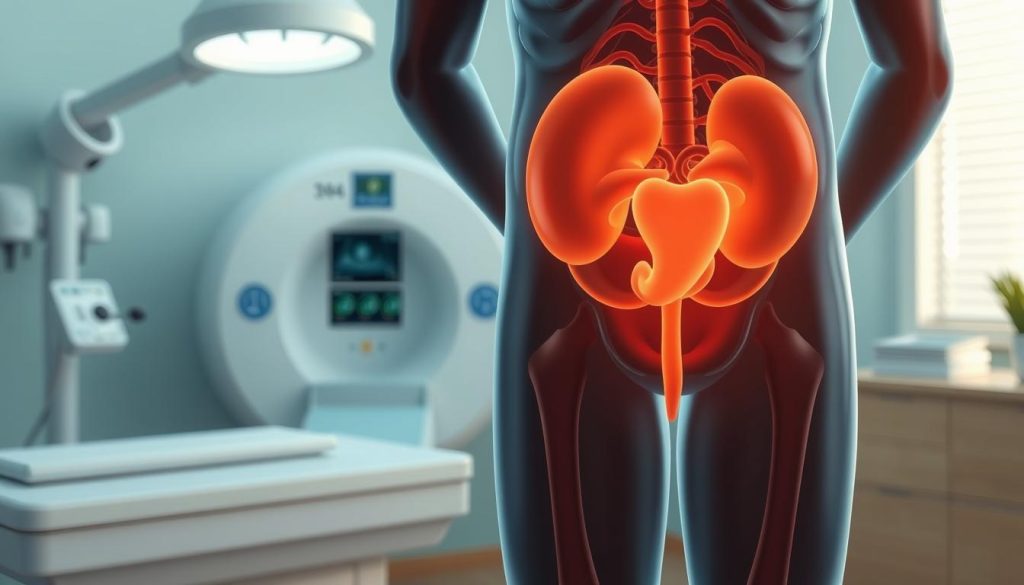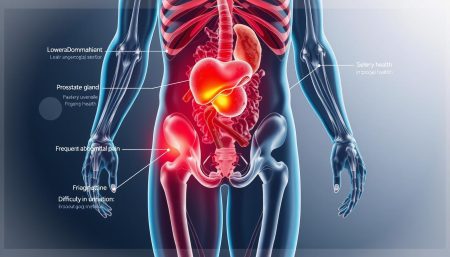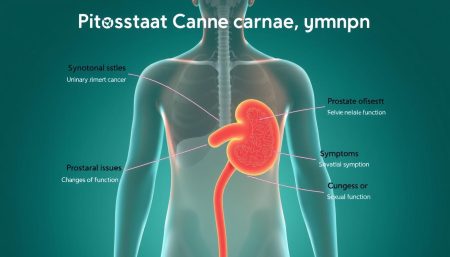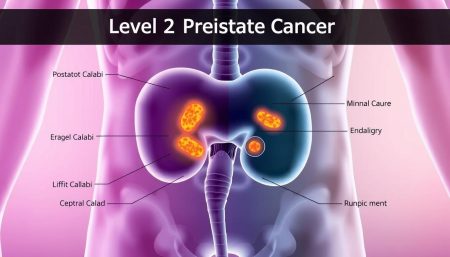Spotting prostate cancer early can greatly improve treatment chances. This guide will help you understand the signs and how to screen for prostate cancer. Knowing these things can help you catch it early, thanks to early detection of prostate cancer.
We’ll look at common symptoms, risk factors, and important tests for prostate health. It’s important to know that not all symptoms mean cancer. But being proactive about your health is key. Let’s explore prostate health and find out how to spot potential issues.
Understanding Common Signs and Symptoms of Prostate Cancer
Spotting prostate cancer symptoms early can improve treatment chances. These signs don’t always mean cancer, but they’re worth checking with a doctor. Let’s look at key signs that might help you figure out if you have prostate cancer.
Urinary Changes and Difficulties
Urinary habits changes often point to prostate problems. Men might notice:
- Frequent urination, especially at night
- Weak or interrupted urine flow
- Difficulty starting or stopping urination
- Sudden urges to urinate
Sexual Function Changes
Prostate cancer can mess with sexual health. Some men see:
- Difficulty achieving or maintaining erections
- Decreased libido
- Pain during ejaculation
Pain and Discomfort Signals
Unexplained pain in certain spots might mean advanced prostate cancer:
- Lower back pain
- Hip or pelvic discomfort
- Bone pain, particularly in the spine, hips, or ribs
Keep in mind, these symptoms can also mean other health problems. If you’re worried about any changes, talk to your doctor. They can check you out and suggest tests.
How Can You Tell If You Have Prostate Cancer: Key Warning Signs
It’s important to know the signs of prostate cancer for early detection. Some symptoms can be similar to other health issues. But, being aware of these signs can lead to a timely diagnosis.
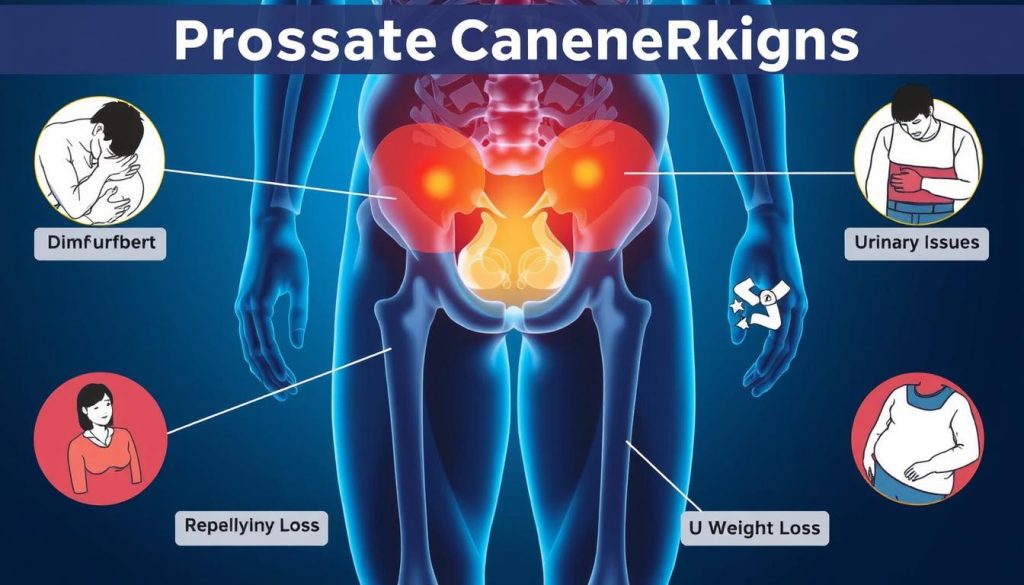
Unexplained weight loss and fatigue are often overlooked but are key indicators. If you lose weight without changing your diet or exercise, talk to your doctor. Also, if you’re tired even after resting well, it could be a sign of a health problem.
Bone pain, especially in the hips, spine, or ribs, might mean advanced prostate cancer. This symptom is not common in the early stages but should not be ignored.
- Swelling in the legs or pelvic area
- Numbness or weakness in the legs or feet
- Loss of bladder or bowel control
These symptoms can mean a growing tumor is pressing on the spine or nerves. Regular health check-ups are key to catching problems early.
“Early detection saves lives. Don’t hesitate to discuss any unusual symptoms with your healthcare provider, no matter how insignificant they may seem.”
| Warning Sign | Possible Indication | Action |
|---|---|---|
| Unexplained weight loss | Potential cancer growth | Consult doctor |
| Persistent fatigue | Body fighting disease | Seek medical advice |
| Bone pain | Possible metastasis | Immediate medical attention |
| Swelling/Numbness in lower body | Tumor pressure on nerves | Urgent doctor visit |
Seeing these symptoms doesn’t mean you definitely have prostate cancer. They can also be signs of other conditions. The most important thing is to stay alert and make sure to have regular check-ups for your health.
Essential Screening Tests for Prostate Cancer Detection
Screening for prostate cancer is vital for early detection. Regular check-ups can find cancer before symptoms show. This increases the chance of successful treatment.
PSA Blood Test Explained
The PSA test checks for prostate-specific antigen in blood. High levels might mean cancer, but other things can affect the results. Your doctor will look at your age and health history to understand the numbers.
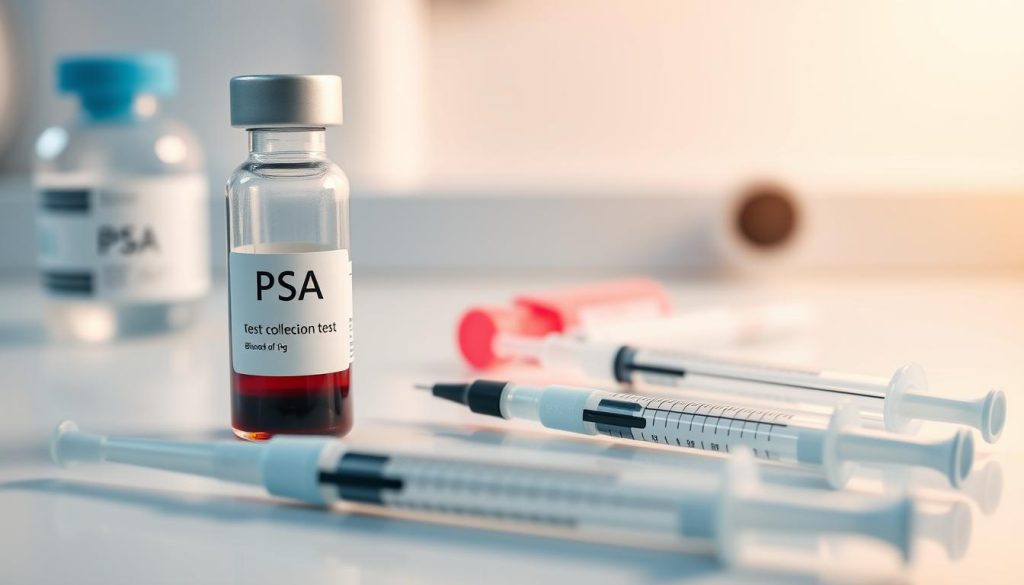
Digital Rectal Examination Process
A digital rectal exam lets the doctor feel the prostate gland for any oddities. This quick check can find lumps or hard spots that could be cancer. It’s often done with the PSA test for a full screening.
Advanced Imaging Technologies
If tests show concerns, doctors might use MRI or CT scans. These scans give detailed pictures of the prostate. They help doctors find tumors or guide more tests.
Prostate Biopsy Procedures
A prostate biopsy is the only sure way to diagnose cancer. It takes small tissue samples from the prostate for a microscope check. Though it might be uncomfortable, it’s crucial for a correct diagnosis.
| Screening Method | Pros | Cons |
|---|---|---|
| PSA Test | Non-invasive, Quick results | Can be affected by non-cancerous conditions |
| Digital Rectal Exam | Can detect physical abnormalities | May miss small tumors |
| Imaging | Detailed view of prostate | Expensive, Not always covered by insurance |
| Biopsy | Definitive diagnosis | Invasive, Risk of complications |
Regular screenings are key to catching prostate cancer early. Talk to your doctor about which tests are right for you based on your age and risk factors.
Risk Factors That Increase Your Chances of Prostate Cancer
Knowing about prostate cancer risk factors is key to catching it early. Some risks can’t be changed, but others can with lifestyle choices. Let’s look at the main factors that might up your chance of getting this disease.
Age and Family History Considerations
Men’s risk of prostate cancer goes up with age. Most cases hit men over 50, with an average age of 66. Family history also matters a lot. If your dad or brother had it, your risk doubles. This shows why knowing your family’s health history is so important.
Racial and Ethnic Risk Factors
Prostate cancer doesn’t hit everyone the same way. African American men face a higher risk and often get more aggressive forms. They’re also diagnosed younger than others. These facts point to the need for special screening and awareness efforts.
Lifestyle and Environmental Influences
Some lifestyle choices can raise your risk. Eating a lot of red meat and full-fat dairy might increase it. Being overweight is also linked to more aggressive cancer. But, eating well and exercising can help lower your risk. Knowing these factors helps you make better health choices and spot signs of advanced prostate cancer early.
FAQ
Q: What are the most common symptoms of prostate cancer?
A: Common symptoms include changes in urination and sexual function. These can be frequent urination, weak urine flow, or trouble starting/stopping urination. You might also feel pain in your pelvic area, lower back, or hips.
But remember, these symptoms can also mean other health issues. Early prostate cancer might not show any symptoms at all.
Q: How is prostate cancer typically diagnosed?
A: Doctors use several tests to find prostate cancer. They check your blood for PSA levels and do a digital rectal exam (DRE). Sometimes, they use MRI or CT scans for more information.
A biopsy is needed to confirm the diagnosis. This involves taking tissue samples to look for cancer cells.
Q: At what age should men start getting screened for prostate cancer?
A: Men should talk to their doctor about screening at age 50 if they’re at average risk. African American men and those with a family history of prostate cancer might start earlier, around 45.
Men with a family history of prostate cancer before 65 might start even earlier, at 40.
Q: What are the risk factors for developing prostate cancer?
A: Risk factors include age, family history, and race. African American men are at higher risk. Genetic mutations and lifestyle choices like diet and exercise also play a part.
Talk to your doctor about your personal risk factors.
Q: Can prostate cancer be prevented?
A: There’s no sure way to prevent prostate cancer. But, a healthy diet, exercise, and not smoking can help. Some studies suggest finasteride or dutasteride might lower risk, but they have side effects.
Always talk to your doctor about these options.
Q: What is the PSA test and how reliable is it?
A: The PSA test measures PSA levels in your blood. It’s a useful tool but not perfect. High PSA levels can mean cancer, but also other issues like prostatitis.
Some men with cancer have normal PSA levels. So, the PSA test is used with other methods for a better diagnosis.
Q: What are the signs of advanced prostate cancer?
A: Advanced prostate cancer can cause severe symptoms. These include bone pain, unexplained weight loss, and fatigue. You might also have trouble urinating or see blood in your urine.
Seek medical help right away if you notice these symptoms.
Q: How often should I get screened for prostate cancer?
A: How often you should get screened depends on your age, risk factors, and PSA test results. Here are some general guidelines:
– Men aged 50-70 with a PSA level below 3 ng/mL should get screened every 2-4 years.
– Men with a PSA level of 3 ng/mL or higher might need more frequent screening or additional tests. Always talk to your doctor about the best screening schedule for you.












